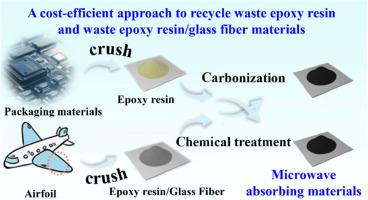利用化学镀磁性颗粒和碳化微波吸收法回收玻璃纤维增强环氧树脂废料
IF 14.3
1区 材料科学
Q1 MATERIALS SCIENCE, MULTIDISCIPLINARY
引用次数: 0
摘要
塑料废物回收是当今可持续发展努力的一个重点。处置不当会导致二次污染,对环境和人类健康构成威胁。在本研究中,我们的目标是通过化学镀和碳化工艺回收废弃环氧树脂和玻璃纤维增强环氧树脂复合材料,设计高附加值的微波吸收碳材料。通过对固体废弃物进行粉碎,并在其表面引入磁性金属纳米颗粒,成功研制出具有优异微波吸收性能的复合碳材料。具体而言,将镍颗粒掺杂到玻璃纤维/环氧树脂衍生的碳材料中,获得了5.9 GHz的宽有效吸收带宽(EAB),匹配厚度为1.9 mm,几乎覆盖了整个Ku波段,同时实现了最小反射损耗(RLmin) - 36 dB。优越的吸收性能归因于电磁波在材料内部的多次反射或散射,以及传导和磁损失,偶极子和界面极化效应。研究结果表明,通过合理的设计和优化,废环氧树脂和废玻璃纤维增强环氧树脂基复合材料可以有效地回收为高性能吸波材料,为废物资源化利用提供了一条简单有效的途径。本文章由计算机程序翻译,如有差异,请以英文原文为准。

Recycling glass fiber-reinforced epoxy resin waste via electroless plating magnetic particles and carbonizing for microwave absorption
Plastic waste recycling is a focal point in today's sustainable development efforts. Improper disposal can lead to secondary pollution, posing threats to the environment and human health. In this study, we aim to recycle waste epoxy resin and glass fiber-reinforced epoxy resin composites via an electroless plating and a carbonization process, to design high-value-added carbon materials for microwave absorption. By pulverizing solid waste and introducing magnetic metal nanoparticles onto its surface, a composite carbon material capable of excellent microwave absorption performance was successfully developed. Specifically, doping nickel particles into carbon materials derived from glass fiber/epoxy resin achieved a wide effective absorption bandwidth (EAB) of 5.9 GHz with a matching thickness of 1.9 mm, covering nearly the entire Ku band, and achieving a minimum reflection loss (RLmin) of −36 dB simultaneously. The superior absorption performance is attributed to multiple reflections or scattering of electromagnetic waves within the material, as well as conduction and magnetic losses, dipole and interfacial polarization effects. These results demonstrate that through rational design and optimization, waste epoxy and waste glass fiber-reinforced epoxy resin-based composite materials can be effectively recycled into high-performance microwave absorbing materials, offering a straightforward and efficient pathway for waste resource utilization.
求助全文
通过发布文献求助,成功后即可免费获取论文全文。
去求助
来源期刊

Journal of Materials Science & Technology
工程技术-材料科学:综合
CiteScore
20.00
自引率
11.00%
发文量
995
审稿时长
13 days
期刊介绍:
Journal of Materials Science & Technology strives to promote global collaboration in the field of materials science and technology. It primarily publishes original research papers, invited review articles, letters, research notes, and summaries of scientific achievements. The journal covers a wide range of materials science and technology topics, including metallic materials, inorganic nonmetallic materials, and composite materials.
 求助内容:
求助内容: 应助结果提醒方式:
应助结果提醒方式:


